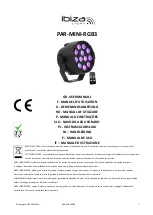
Operating Instructions Ascoline 700, AEH 35x
ascobloc
Gastro-Gerätebau GmbH
01156 Dresden, Grüner Weg 29
Germany
Tel. +49 351 4533-0
Fax +49 351 4537-339
E-mail:
AEH 35x_d.doc, Status: 19.04.2013
Subject to change without notice!
6
You can now put the main switch for the cooking zones to -0-. The green pilot light goes out.
The pot/pan diameter should not be smaller than the circle shown in the front cooking zone. The cooking zone
monitoring does not switch the power on till a sufficiently large pot is placed on the hob. Parboiling at high power
and simmering at low power. The setting needed for simmering depends on the condition of the cooking utensils
and the quantity of food to be cooked.
Only use pots with flat, smooth and clean bottoms that the manufacturer has indicated as being suitable for
induction heating. Do not use enamelled pots! Rough bottoms on utensils cause scratches when slid across the
glass ceramic surface.
5.2.1 Pot detection
Pots with a diameter of less than 12 cm are not detected. The control lamp lights up when in operation. No heat is
generated when there is no pot on the hob or when the utensil is of an unsuitable material, the control light
flashes only briefly.
Use a magnet to check whether a cooking utensil such as a pot or pan is suitable. The pan is suitable if the
magnet clings to the bottom of the pan.
If not, your pan is not suitable for induction appliances. Choose a pan material suitable for induction heating.
5.2.2 Monitoring the heating zone
The heating zone is monitored by a temperature sensor located under the glass ceramic plate. Overheated pots
(hot oil, empty pans) can be detected. The supply of heat is stopped. The appliance does not supply heat again to
the pot till the temperature has regained a normal value (230°C).
ATTENTION!
The overheated cooking utensil is first detected when the glass ceramic reaches the switch-off temperature
(260°C).
Generation of noise
The cooling fans are audible, but switch off again from time to time. Whistling noises due to the different working
frequencies can be heard when close to the appliance.
The noise can be prevented by:
° Altering the power level
° Using different cooking utensils
The ventilation starts to work when the temperature of the heat sink e45°C. At heat sink temperatures
above +70°C, the monitoring of the heating reduces automatically to keep the power unit at normal operating
conditions.
The induction appliance continues to run at reduced maximum power.
5.3 Cleaning
Please observe the hygiene regulations in your firm! The instructions in this document are not a substitute for
such regulations (observe the tips for the treatment of stainless steel appliances in commercial kitchens!).
Attention!
Appliances may not be cleaned using water under pressure (spraying with water hose or steam jet or
high pressure cleaners). The appliance is to be shut off if the surroundings are to be cleaned using such means!
The appliance must be shut off and adequately cooled down before cleaning. Appliance parts or accessories that
come in contact with foodstuffs must be cleaned thoroughly with cleaning agents and then rinsed off with tap
water. Flammable liquids are not be used for cleaning.
To avoid interruptions in operation and for hygiene reasons, the appliance should be cleaned daily after use.
Glass ceramic
The glass ceramic cooking surface is easier to clean than conventional ones but also needs to be cleaned
regularly.
To remove coarse deposits, the glass ceramic cleaning scraper (ACC 560) is an absolute must. Unsuitable
scrapers or spatulas can damage the glass ceramic surface and the surrounding silicone seal!
If anything boils over or is spilled, wipe it off immediately before any incrustation can form.
Keep everything that can melt, e.g. plastics, films, especially sugar and food with a high sugar content, away from
the hot cooking hob. If anything melts onto the surface, remove it immediately (even in the hot state) using the
glass ceramic scraper in order to avoid damage.
Clean the cooking zones several times daily, especially at the end of the working day. A little wash-up liquid and
a damp cloth are sufficient for slight soiling. If the soiling is somewhat heavier, first remove the coarse deposits
from the cooking zone using the correct scraper. Then clean with fine scouring liquid, a coarse scrubbing brush or
with soap-filled steel shavings (e. g. AKO pads, Abrazo).





























